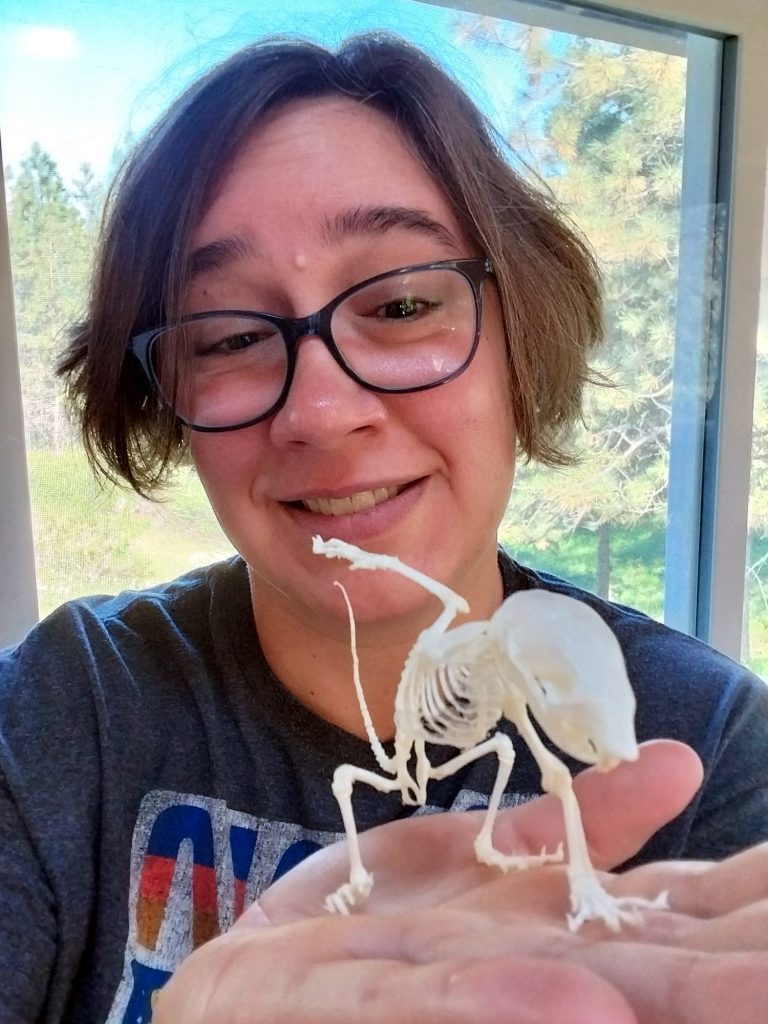
I’m so excited to bring you the next Slow FI Interview with Meg Lyman, a woman I met in the Slow FI Facebook group. When Meg shared her story, I was fascinated.
For Meg, financial independence was never about not working. She’s always had so many hobbies and things that she wanted to explore. Instead, building financial freedom would provide her with the ability to explore all of these options.
In 2020, Meg had some mental health struggles (who didn’t in 2020?). While working through them, she decided to go part-time at her engineering job. This decision has opened up so many opportunities for her to explore doing work she loves and build it into a portfolio career.
Let’s get into the interview.
1. Tell me a little bit about you.
I’m Meg, a 43-year-old who has a 22-year engineering career all at one company. My spouse and I currently live in eastern Washington with our three cats. I’ve worked all around the country in some pretty cool roles with airplanes and gas turbines (for electricity generation).
For my whole life, my interests have been scattered all over the map. I always felt the pull of activities outside work. In other words, I had lots of hobbies! I’ve made some deliberate choices about them over the years, narrowing my after-work focus on two: fine art and skull cleaning.

About 15 years ago, I made my fine art into an official business. About 7 years ago, I turned skull cleaning into a money-making venture. Around that time I also discovered FI. I’d always been a saver, so I was in a fairly good place. The idea that I wouldn’t have to work in engineering anymore and I could do my own thing full-time was incredibly motivating. I was hooked.
2. What deliberate decision have you made to slow down and improve your life?
In 2020, I decided to negotiate to go part-time in my engineering career, and I now work 24 hours/week with the company I’ve worked for over 20 years.
As you can probably imagine, all of my work (including my businesses) plus the usual running of a household and traveling for work and family kept me very busy. But, in 2020, several things happened all at once.
- I hit the 20-year work anniversary
- The pandemic was just getting going
- I was working on a very stressful project where I worked for more than a month without a day off.
This was the perfect storm. Getting to the 20-year mark at my company (during a global pandemic) made me reflect on what I’ve accomplished and what I want to do with the rest of my short time on this planet. I have so many varied interests and skills. Was this what I wanted to spend the majority of my time doing?
I was already reflecting on my life and thinking about some big-picture changes when the solid month of stressful work pushed me into my first anxiety attack. I am usually the type of person to push through rough patches. But this time, my body wouldn’t let me.
This situation forced me to immediately make some big decisions that I’d been thinking about for years. I thought about quitting or going part-time. I knew I needed to look at the numbers and see what the impact of a decision like this would be on our FI timeline.
I made a lot of spreadsheets and plugged my numbers into every FIRE calculator I could find. I realized that we were well past Coast FI.
Jess’ Note: Coast FI is the point at which you no longer need to save for your traditional retirement. What you already have already saved and invested will grow to provide you with what you need.
In fact, we were only a few years away from achieving full FI. And, switching to a Coast FI approach wouldn’t actually add much to our timeline.
I also knew I could continue making money. I had many years of data for my business, and I knew how much I could make working nights and weekends. I knew I could make more if I had more time to spend on it.
I decided to request part-time work. I was really nervous about it. But, it turns out that 20 years of experience is valuable to the business. I took a week off and came back working 24 hours/week.
I went from being the most stressed I’ve ever been to the most excited. I knew in my bones it was the right thing for me.
3. How has the decision to go part-time impacted your quality of life?
For me, FI was never about slowing down, but about using my time in fulfilling, rewarding ways.
My perspective immediately shifted from, “What if I never get to explore these other life possibilities?” to, “I’m actually doing it!”

That shift itself immediately erased a lot of my stress. Engineering had been my focus for 20 years, and that was enough. I was finally going to see what else I had to offer the world.
With reduced stress, my health improved almost overnight. My doctor had previously recommended that I reduce my stress, and I laughed at him. Wouldn’t we all reduce our stress if we could? But, he was right. It made a much bigger difference than I expected.
Overall, the most important thing is that I got some of my time back. When almost all of our waking hours are consumed by work and the workings of daily life, each free hour feels like a precious resource that you have to mete out like a miser. Now that I have ample free time, I don’t think twice about visiting a friend or traveling to spend time with family. Stress edges out room for joy, and it’s nice to have that back.

Lastly, in the last year and a half, since I went part-time, I’ve ramped up both of my businesses, choosing only projects that spark my interest. I’m now working just as many hours, but being able to choose my work makes all the difference. My part-time engineering job has its moments (don’t they all?), but the workload is much more manageable. I have 4-day weekends, and my work is structured so that I have to take time off if I exceed my hours. That’s helped me set work boundaries in a way I couldn’t before.
4. How did going part-time to build a portfolio career impact your financial goals or timelines?
We’ve always been a frugal family, living below our means and saving. We also moved to a lower-cost-of-living area in 2017 when mortgage rates were low.
Engineering isn’t the gold mine it used to be, but it pays well enough that 60% compensation can cover our expenses and allow us to save a little. I can no longer max out my HSA or 401k contributions anymore, but I can still get the company match.
Thankfully, my healthcare costs have remained the same, since my hours still allow me to be considered a full-time employee at my company.
We were already in a good place financially, so going part-time only moved our FIRE date back about 2 years. Honestly, the time delay didn’t matter much to me. My brain was demanding a break, so we made it work. At the time, I felt like I could do part-time work for another ten years, but I wouldn’t survive even one more month of full-time work.
5. What enabled you to make the decision to go part-time and build a portfolio career?
Having the FI community out there, with all its myriad experiences and advice, gave me the confidence that this plan would work. I loved reading the success stories of regular people (like me!) who showed me that this was possible.
I wasn’t ready to retire yet, but I could make my own hybrid Coast/Barista/Slow FI plan.
Note from Jess: I defined Coast FI above, but I’ll define Barista and Slow FI as well.
Barista FI (or semi-retirement) is when you can start drawing down on your assets or retirement accounts to cover part of your cost of living, but you still need to generate some active income as well.
Slow FI is a philosophy focused on using the financial freedom we gain along the path to FI to design lives we truly love. Coast FI and Barista FI both fall under the Slow FI umbrella.
Ok back to Meg…
For me, part-time is the best of both worlds. You still have the social support that comes from having a career, but your life isn’t wholly dedicated to it anymore. It gives you the chance to test out what you want to do next, which for me, was to prove out a side business.
Another thing that helped enable this was that I made good use of my extensive support network (family, friends, my therapist, etc.) to work through all of my feelings. I was asking questions like:
- Do I owe the world more engineering?
- Do I owe it to my parents and their expectations to have a successful career?
- Why do I feel guilty that I’m not as gung-ho about work as my colleagues?
- Why do I feel guilty that I have the privilege of considering part-time work?
- Why do I feel like I don’t deserve it?
In the end, I still wasn’t “ready,” but my body decided that I needed a change. All this support helped me get to the place I am today.
6. Were there things in your life you adapted so you could continue to work toward your goals?
We did cut a little fat out of our budget to make sure part-time would work. For example, we consciously cut back on things like fancy alcohol, junk food, and dining out. We still do some of these things, but they now feel like treats. We’ve also seen benefits to our health as well.
Additionally, we don’t buy many things. We have enough pots and pans, decor, and clothes. We don’t buy much except consumables or replacements for things that wear out. We don’t care much about fashion and don’t really need work clothes, so cutting this out was pretty painless.
We were also recently able to cut our cell phone bill by 75% by finding an MNVO (mobile virtual network operator) in our area. These are companies that lease wireless capacity from large operators, so they have fewer costs.
It turns out, we didn’t actually need to cut back as much as we did because we are also spending less than expected. This has helped us bulk up our emergency fund, which we’re now using to do some house projects.
Because we were already used to spending consciously, the transition wasn’t painful.
7. How did your pursuit of FI help or hinder your decision to go part-time and build a portfolio career?
I get the feeling this would have happened even if we were 20 years away from FI. But, our pursuit of FI helped in two ways. First, pursuing FI meant I’d already done all the budgeting and math. I knew our family’s financial needs inside and out. This made it a lot easier when I needed to figure out the numbers and see if they worked.
Second, having “F-You Money” made it much easier to ask for part-time work.
Note from Jess: F-You money is when you have the money saved (that you can easily access) that allows you to get out of a bad situation or take advantage of an opportunity.
If I’d been told that I couldn’t go part-time, I was prepared to quit. Luckily, I never needed to mention that, but knowing it gave me confidence that probably showed through in my request.
8. Why and when do you think someone might consider “downshifting?”
Growing up in a capitalist society, one question that doesn’t come up often is, “What is enough?” We always look for the next promotion, the next raise, or the next deal. It takes a lot of perspective shift to go from that to “I have enough.”
Each person needs to define what enough means for them. Our years are limited, and you deserve to explore all the things you have to offer the world. That usually means downshifting a career, and I’d like to see more people seriously consider it. Make the best of your years here.
9. What advice do you have for someone considering a similar decision?
It took me several years to get here, and I felt a lot of uncertainty throughout the process. But, I have never once regretted anything about going part-time. It is the best decision I’ve ever made. If you are on the fence, I’d encourage you to do it. I guarantee you’ll regret not trying it. Give yourself that chance.
Thank you, Meg, for sharing your story with us! And, thank you for the reminder that the slow in Slow FI isn’t necessarily about the speed at which you reach FI. Instead, it’s about intentionality and “using our time in more rewarding and fulfilling ways.”
Working part-time can be an awesome way to ease into running your own business or building a portfolio career. You don’t have to quit your job to do this. You can start to ramp down the time you spend working at your (former) full-time job, which can provide you with the time needed to build up side hustles or pursue other activities.
Going part-time at work allowed me to have the time and space needed to work on the Fioneers and start my coaching business. For Meg, part-time work has allowed her to invest more time into her side businesses (fine art and skull cleaning). Part-time work was the gateway to building a portfolio career doing work she enjoys.
Meg also mentioned running the numbers and realizing that her timeline to reach FI would be increased by about two years. Two years is such a short amount of time, especially when you are enjoying your life so much more.
And, I bet this decision may not actually add two years to the FI timeline. When I went part-time, we assumed it would add two years to our timeline as well. But, it ended up not changing our FI timeline at all because of two reasons. First, we ended up spending a lot less when I was no longer overly stressed about work. Second, I ended up making more money than expected from side projects. I wouldn’t be surprised to see this for Meg too!
If you’d like to learn more about Meg’s Fine Art of Skull cleaning work, you can find her in the following places:

- Fine Art: Instagram @MegLymanArt
- Skull Cleaning: Instagram @PacificRemains
























